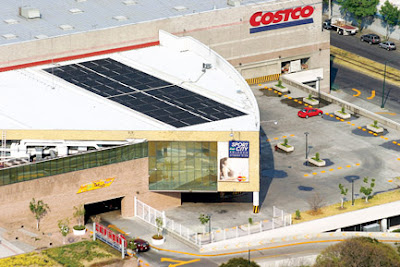According to international energy experts, solar
thermal technology could replace almost a sixth of the world’s low-temperature heating
use by 2050.
Yesterday, Paolo Frankl of the International Energy Agency (IEA) presented a
technology roadmap for solar heating and cooling at the International Conference
on Solar Heating and Cooling in Buildings
and Industry. The study found that a stable, long-term policy framework for
solar heating and cooling should be a key task for governments in the coming
decades.
The Paris-based IEA says solar energy has the potential
to tackle climate change and strengthen global energy security, particularly
when used in low-temperature heating and cooling applications. Clean, renewable
solar power could replace fossil fuels used for heating and electricity for hot
water and for heating buildings.
"The IEA's Solar
Heating and Cooling Roadmap confirms the great opportunity that lies in
using solar thermal to replace fossil fuels and electricity,” says Werner
Weiss, chairman of the IEA Solar Heating and Cooling Programme, which provided
important expertise to the roadmap. “It rightly identifies reliable long-term
framework conditions as the key challenge for the coming years. And, it does
not overlook the role of non-economic factors that currently hinder an even
quicker adoption of solar thermal energy technologies.”
 |
| Solar water pre-heating successfully makes use of low-temperature solar thermal technology to reduce dependance on fossil fuels and electricity. This large-scale, industrial pre-heating system uses Heliocol solar collectors. |
Without decisive action, energy-related emissions
of carbon dioxide will more than double by 2050 and increased oil demand will
heighten global concerns over the security of supplies, says IEA Executive
Director Maria van der Hoeven.
“We can and must change our current path, but this
will take an energy revolution and low-carbon energy technologies will have a
crucial role to play,” says van der Hoeven.
Among solar thermal applications, hot water production and space
heating are the most important. By 2050, 213 Million Tons of Oil Equivalent
(MTOE) could be covered by solar energy, the IEA finds. The nascent market for solar heat for industrial
processes could be the second largest with 171 MTOE in 2050. Solar swimming pool heating and solar
cooling could provide another 45 MTOE.
The IEA says it is calling on all stakeholders to
work toward realizing the vision outlined in the roadmap, with a specific call
for governments to take a lead role in creating a favorable investment climate
by creating a stable, long-term policy framework for solar heating and cooling.
Sudden changes in available financial support have
proven detrimental to the development of a healthy solar thermal industry in
many countries. Therefore, the IEA concludes, economic incentive schemes should
be independent from state budgets to avoid "stop-and-go.”
However, support policies should not only focus on
economic aspects, the IEA says. In many regions of the world, solar thermal is
already cost-competitive with conventional technologies, but barriers, such as
higher upfront investment and lack of trained installers keep people from
choosing solar heating and cooling.
According to the IEA, more research and development
could jump-start the adoption of solar heating and cooling solutions in
emerging areas, such as heat for industrial processes and cooling.
Governments should provide the necessary R&D
funds to support these developments, the organization says.
"We can only underline the importance of
research, demonstration and development,” says IEA SHC chairman Weiss. “Our
program provides a very successful framework for international cooperation in
the research on solar thermal and solar buildings. By working together,
governments can help achieve our even more ambitious goal: to supply, by 2030,
50 percent of the low-temperature heat demand with solar energy.”